The Kiel scientists who have completed the study, but at the same time, warn significant risks for okosystems with increased CO2 recording
The first companies have already been founded in order to be at the front of the lucrative emissions trading of carbon dioxide certificates with the seasons. Especially only the International Maritime Organization (IMO) has uplifted its concerns about such coarse interventions on climate change and confessed to regulate such attempts (critics of commercial seaweed for climate control achieves first success). A scientific team under the direction of the Leibniz Institute for Sea Sciences (IFM-Geomar) in Kiel has now submitted a study after which the seasons could be more efficient when he has previously adopted.

Microalgae under the microscope: CO2 eaters in the ocean, A. Stuhr, IFM-Geomar
For example, half of the greenhouse gas emissions caused by people have been absorbed by the seas, reducing the pH of the sea surface. Algae, the so-called phytoplankton, play a rough role, they take up to photosynthesis CO2, deposit oxygen and store a part of the absorbed carbon when they descend and fall to the ground, on the seabed, which is called the biological carbon pump. Whether the seas can continue to record with growing emissions in Selbemab CO2, is controversial. Only short-lived scientists reported that the inclusion in recent years has already been inflicted. Also unknown is what consequences could have a further reduction of the pH of the water.
In a trial in a Norwegian fjord of Bergen, the scientists of the Leibniz Institute for marine sciences with their colleagues in 2005 have nine "Mesocosm" set up as you in Enhanced Biological Carbon Consumption in A High CO2 Ocean, published in the magazine Nature (Doi: 10.1038 / Nature06267), write. This is 10 meters deep and 27 cubic meters of water-catching sauces. The CO2 content of the air in these "Mesocosm" were simulated under the present conditions as well as among the for 2100 and 2150 predicted values.

Two of the mesocosmen introduced in the fjord. Image: iFM-geomar
In the increased CO2 content of the air, the phytoplankton in the hinges also increased up to 39 percent more carbon, which sank to the ground at the end of the planktonblood with the dying algae cells. However, the scientists watched the reactions only for a period of 24 days. During the experiment, fresh water and phosphorus and nitrates were supplied. With the Algaebluten, the composition of the dominant algae species changed, but with increased growth, the above-mentioned nutrients (nitrates, phosphates, silicates) were also consumed faster. After about 12 days was the highlight of the algae blossom.
The scientists say they had been surprised in which the phytoplankton has responded to the changed CO2 values. The increasing recording of CO2 was able to noise the projects of the companies, the seas in nutrient regions to tend to pump more carbon from the air on the seabed. However, the scientists warn "significant risks and side effects". Thus, a coarse CO2 recording through the phytoplankton the acidification also streens the deep sea. In addition, more oxygen was deprived of the deeper water layers. And the changing of the phytoplactone due to stronger CO2 recording could also change their function for the food network. Fruhere studies had pointed out that small crabs who were fed to carbon richer microalgae reacted with a lesser growth rate and reduced success in reproduction.